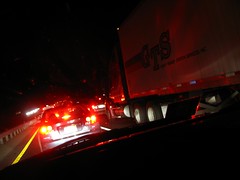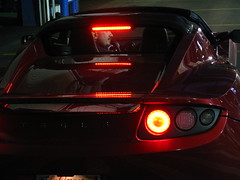
If only the street was the same way. But it's not, and the safest drivers, in my opinion, are 360-degree aware. Concerned with who, if anyone, is tail-gaiting; sure of what's behind when considering an unpredictable maneuver, etc. And particularly on the motorcycle, considering the rear view before chopping the throttle or braking hard.
That last point is worth expanding-upon. Chopping the throttle and braking. I'm sure I'm the billionth person to recognize that throttling-off on a motorcycle can often take the place of braking. There is a relatively violent deceleration on most of the motorcycles I've ridden. It's nice because you can spend less time on the brake and use one input control to regulate your speed - both for corner entry and exit in addition to simply managing your speed. However, in traffic you may slow from 15 MPH to 5 just by cutting the throttle (in a very short amount of time). Most vehicles would require the driver to apply the brakes to achieve such rapid decel. And they'd advertise that action with bright red lights for all behind them to see. But the motorcycle that shed 10 MPH just by cutting the throttle did no such thing - lets hope the driver behind has kick-@$$ depth-perception! Or lets just hope they're paying attention at all.

But like I said, I'm the billionth person to recognize this. I'm pretty sure I was told at my MSF course, some 10 years ago, to apply the brake lever when "engine-braking." Just so that the drivers behind are aware that you're slowing down. In the interest of minimizing risk, it's probably a good idea. Maybe not always convenient, but putting on this show for the cars behind you scores you extra visibility points. I consider this every time I'm on the road. I don't always employ it, but I consider it almost every time I slow down for a red light.
It takes thought - split seconds of thought that could go somewhere else. And while I never cared about those lost brain cycles before, I'm contemplating them now because I recently learned that the Tesla Roadster fires the brake lights on throttle-off.
Wha?

Yep. Weird, right? My initial reaction was that it's a bad idea, that it misrepresents what's really going on, and that I don't like it. But after I shook-off the self-imposed insult to my person, I reconsidered the whole idea with a bit more of an open mind. Think about not having to think about that brake lever when you chop the throttle on a motorcycle. I kinda dig it. One control to accelerate, slow down (even violently), and notify your tailgaiters that you're decelerating. I think that would be a nice feature.
However, there appear to be negative sides to this feature of the Tesla Roadster, as described by VFX on teslamotorsclub.com:
http://www.teslamotorsclub.com/showpost.php?p=46373&postcount=143
I think his points are valid, and they center around the fact that many drivers assume that a vehicle is decelerating significantly when the brake lights fire. Now how do we define significantly? I think we can do it with a value. And if we can determine a value at which deceleration becomes significant, then we can simply employ an accelerometer to turn the brake lights on and off, right?
I like the idea of linking brake lights to more than just the brake pedal. I think it can be done smartly, safely, and it can afford me one less thing to think about while slowing down. What do you think?
No comments:
Post a Comment